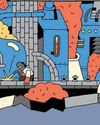
It was a rare sight at last year’s pandemic-interrupted U.S. Open: a crowd. One afternoon in late August, a group of about 80 male tennis players in T-shirts and masks gathered at the Grandstand stadium in Flushing Meadows, filling up rows of dark-blue seats, like schoolboys assembled for a socially distanced class picture. The only action on the court below was a practice session. The 57th-ranked female player, Ajla Tomljanovic of Australia, was rallying with a partner, glancing up in bewilderment as the men applauded between points.
The group had been summoned to Grandstand by Canadian pro Vasek Pospisil and Serbian world men’s No. 1 Novak Djokovic. Frustrated with the slow pace of change in elite tennis, Pospisil and Djokovic were aiming to form a players association—not a union, exactly, but a group that could negotiate with tournaments for prize money and threaten boycotts when necessary. The meeting, convened via WhatsApp, was the latest salvo in tennis’s never- ending war with itself.
Djokovic arrived a few minutes late, after winning a grueling match across the complex. He and Pospisil took turns speaking, straining to be heard over the sound of planes roaring above LaGuardia. Their goal wasn’t to dismantle the structure of professional tennis, they assured the group. They simply wanted the executives who run the sport to take players’ concerns more seriously.
This story is from the March 29 - April 05, 2021 edition of Bloomberg Businessweek.
Start your 7-day Magzter GOLD free trial to access thousands of curated premium stories, and 8,500+ magazines and newspapers.
Already a subscriber ? Sign In
This story is from the March 29 - April 05, 2021 edition of Bloomberg Businessweek.
Start your 7-day Magzter GOLD free trial to access thousands of curated premium stories, and 8,500+ magazines and newspapers.
Already a subscriber? Sign In

Instagram's Founders Say It's Time for a New Social App
The rise of AI and the fall of Twitter could create opportunities for upstarts

Running in Circles
A subscription running shoe program aims to fight footwear waste

What I Learned Working at a Hawaiien Mega-Resort
Nine wild secrets from the staff at Turtle Bay, who have to manage everyone from haughty honeymooners to go-go-dancing golfers.

How Noma Will Blossom In Kyoto
The best restaurant in the world just began its second pop-up in Japan. Here's what's cooking

The Last-Mover Problem
A startup called Sennder is trying to bring an extremely tech-resistant industry into the age of apps

Tick Tock, TikTok
The US thinks the Chinese-owned social media app is a major national security risk. TikTok is running out of ways to avoid a ban

Cleaner Clothing Dye, Made From Bacteria
A UK company produces colors with less water than conventional methods and no toxic chemicals

Pumping Heat in Hamburg
The German port city plans to store hot water underground and bring it up to heat homes in the winter

Sustainability: Calamari's Climate Edge
Squid's ability to flourish in warmer waters makes it fitting for a diet for the changing environment

New Money, New Problems
In Naples, an influx of wealthy is displacing out-of-towners lower-income workers